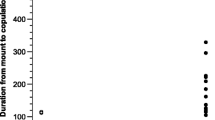Summary
Mating behavior in D. andis was studied both in nature and in the laboratory. Each mating in nature consisted of several repeated copulation and oviposition bouts during which the male stayed mounted. One copulation bout included an intromission in the beginning followed by several tapping sequences. During one tapping sequence the male touched the external genitalia of the female with his claspers several times. The experimental matings with irradiated sterile males contained one copulation bout after which the female laid her eggs. In these matings the percentage fertilization for the last male to mate with the female increased with increasing number of tapping sequences. The percentage fertilization was affected positively also by the time between the end of the copulation bout and the start of oviposition, but the time spent in the copulation bout was not important. Furthermore, there was a negative correlation between the length of intromission and the percentage fertilization. After the copulation bout, the percentage fertilization was higher among the first eggs laid. This difference between the first and later eggs laid increased with the increasing number of tapping sequences, suggesting that copulating and ovipositing in several bouts further increase the male percentage fertilization. In matings recorded in nature, both the number of tapping sequences and the number of copulation and oviposition bouts varied greatly. Of the variables recorded during these matings, individual size and the number of eggs the female contained in the beginning of a mating affected the number of copulation bouts and the number of tapping sequences. Males also mated differently with females containing immature or mature eggs. The male behavior resulting in sperm precedence and the variability of matings in nature in relation to male sperm competition is discussed.
Similar content being viewed by others
References
Alcock J, Buchmann SL (1985) The significance of post-inseminational display by male Centris pallida (Hymenoptera: Anthophoridae). Z Tierpsychol 68:231–243
Barlett AC, Mattix EB, Wilson NM (1968) Multiple matings and use of sperm in the boll weevil, Anthonomus grandis. Ann Entomol Soc Am 61:1148–1155
Brower JH (1975) Sperm precedence in the Indian meal moth, Plodia interpunctella. Ann Entomol Soc Am 68:78–80
Eberhard WG (1985) Sexual selection and animal genitalia. Harvard University Press, Cambridge, MA
Etman AAM, Hooper GHS (1979) Sperm precedence of the last mating in Spodoptera litura. Entomol Soc Am 72:119–120
Gromko MH, Newport ME, Kortier MG (1984) Sperm dependence of female receptivity to remating in Drosophila melanogaster. Evolution 38:1273–1282
Johnson L, Hubbell SP (1984) Male choice. Behav Ecol Sociobiol 15:183–188
Linley JR (1975) Sperm supply and its utilization in doubly inseminated flies, Culicoides melleus. J Insect Physiol 21:1786–1788
Nadel H, Luck RF (1985) Span of female emergence and male sperm depletion in the female-biased, quasi-gregarious parasitoid, Pachycrepoideus vindemiae (Hymenoptera: Pteromalidae). Ann Entomol Soc Am 78:410–414
Otronen M (1984a) The effect of differences in body size on the male territorial system of the fly, Dryomyza anilis. Anim Behav 32:882–890
Otronen M (1984b) Male contests for territories and females in the fly Dryomyza anilis. Anim Behav 32:981–998
Otronen M (1988) Studies of reproductive behaviour in some carrion insects. D Phil thesis, Oxford
Otronen M (1990) Female mating behaviour and multiple matings in the fly, Dryomyza anilis. Behaviour (in press)
Parker GA (1970a) Sperm competition and its evolutionary consequences in the insects. Biol Rev Cambridge Philosophic Soc 45:525–568
Parker GA (1970b) Sperm competition and its evolutionary effect on copula duration in the fly, Scatophaga stercoraria. J Insect Physiol 16:1301–1328
Parker GA (1978a) Evolution of competitive mate searching. Annu Rev Entomol 23:173–196
Parker GA (1978b) Looking for mates. In: Krebs J, Davies NB (eds) Behavioural ecology, an evolutionary approach. Blackwell Scientific Publications, Oxford, pp 214–244
Partridge L, Farquhar M (1981) Sexual activity reduces lifespan of male fruitflies. Nature 294:580–582
Schlager G (1960) Sperm precedence in the fertilization of eggs in Tribolium castaneum. Ann Entomol Soc Am 53:557–560
Smith RL (1979) Repeated copulation and sperm precedence: paternity assurance for a male brooding water bug. Science 205:1029–1031
Villavaso EJ (1975) Function of the spermathecal muscle in the boll weevil, Anthonomus grandis. J Insect Physiol 21:1275–1278
Waage J (1984) Sperm competition and the evolution of odonate mating systems. In: Smith RL (ed) Sperm competition and the evolution of animal mating systems. Academic Press, Orlando, pp 372–420
Walker WF (1980) Sperm utilization strategies in nonsocial insects. Am Nat 115:780–799
Author information
Authors and Affiliations
Rights and permissions
About this article
Cite this article
Otronen, M. Mating behavior and sperm competition in the fly, Dryomyza anilis . Behav Ecol Sociobiol 26, 349–356 (1990). https://doi.org/10.1007/BF00171101
Received:
Accepted:
Issue Date:
DOI: https://doi.org/10.1007/BF00171101




